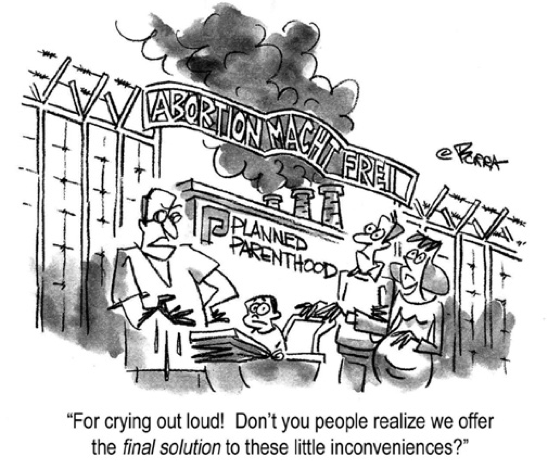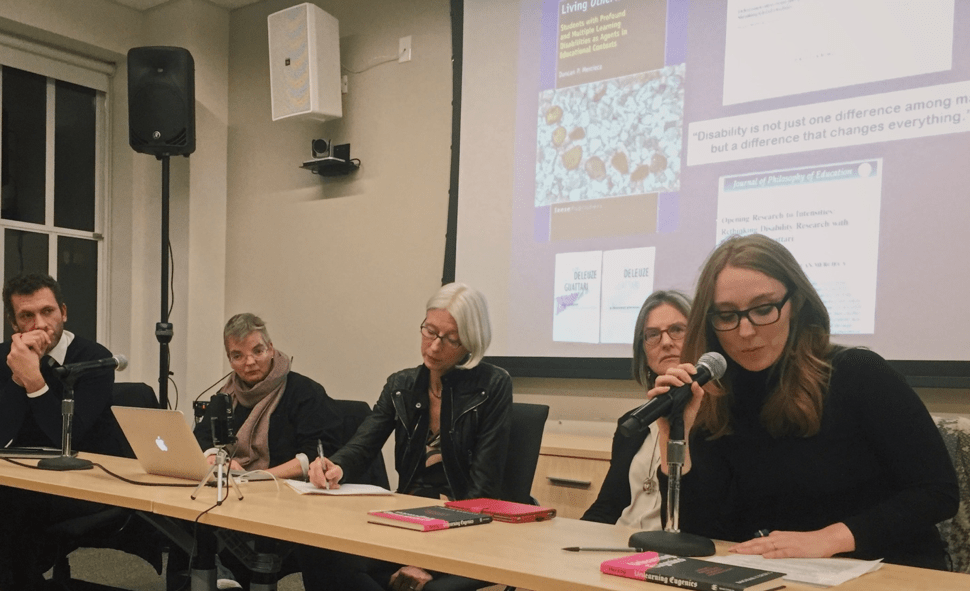By guest contributor Jonathon Catlin
The New York Consortium for Intellectual History recently hosted Dagmar Herzog (CUNY) for a discussion of her new book, Unlearning Eugenics: Sexuality, Reproduction, and Disability in Post-Nazi Europe (Wisconsin, 2018). Three scholars offered responses: Danilyn Rutherford (Wenner-Gren Foundation for Anthropological Research), Johanna Schoen (Rutgers), and Moira Weigel (Harvard), all introduced by Stefanos Geroulanos (NYU). A recording of the event provided by the University of Wisconsin-Madison’s George Mosse Program appears at the end of this article. Herzog’s recent discussion on New Books Network is linked here.
Dagmar Herzog’s provocative new book is based on the George L. Mosse Lectures she delivered at the Hebrew University of Jerusalem in December 2016. In the acknowledgements, Herzog makes a fitting homage to Mosse’s pioneering work on European cultural history and the history of sexuality. Yet Herzog breaks new ground by illuminating the under-studied—but, as she shows, decisive—subject of disability rights. Unlearning Eugenics is a politically shrewd and empathetically attuned culmination of the distinctive critical approach combining attention to sexuality, religion, and the politics of memory we have come to recognize in Herzog’s work since her landmark Sex after Fascism: Memory and Morality in Twentieth-Century Germany (Princeton, 2005). It also proves as essential as her Doktormutter Joan W. Scott’s recent intervention Sex and Secularism (Princeton, 2017) for understanding the complex nexus of religion and sexuality in contemporary Europe.
Unlearning Eugenics tells the surprising story of how two progressive and traditionally allied causes, women’s reproductive rights and disability rights, have become pitted against one another. Since the 1990s, anti-abortion activists across Europe (and now in the U.S. as well) have successfully promoted “restrictions on sexual and reproductive self-determination as justice for the physically and cognitively disabled” (3). Taboos about Nazi eugenics have become a key weapon in the arsenal of the religious right’s campaign to restrict abortion access by conflating abortion on the grounds of fetal anomaly with Nazi eugenics and mass murders of the disabled. Herzog provides a convincing genealogy of this this false association (after all, the Nazis restricted and penalized abortions), with each turn of her narrative unraveling this dubious connection stitch by stitch. In the process, she illustrates the “contrapuntal relationship between different moments in time” and profound “ricochets and repercussions” of the Nazi past in contemporary Europe (10).

Antiabortion demonstrators in Warsaw, June 2011, with banners of bloody fetuses and Adolf Hitler as an abortionist. In the foreground, a feminist counter-demonstrator raises a poster declaring, “Life for fetuses / Death to women,” feminist activists’ summation of the new law proposed in Poland that would have banned all abortions without exception.
The epicenter of these debates was postwar West Germany, where among Protestants and Catholics alike “early pride in having protested the so-called euthanasia murders was generally combined with the message that sexual conservatism needed to be restored and that above all abortion—on any grounds—must remain criminalized” (4). From Germany, to Italy, to France, völkisch anxiety about falling birthrates carried over from the fascist era and in some respects even intensified. Meanwhile, other religious groups defended reproductive self-determination as a moral right in itself, arguing that “‘wantedness’ is a foundational condition of the human quality of human life and that this condition cannot be forced via the threat of punishment” (27). On both sides of the debate, arguments about abortion were haunted by “the persistence of contempt for the disabled” and an inability “to argue straightforwardly for women’s rights to sexual pleasure without reproductive consequences. Abortion quite evidently was never just about itself” (16).
In the 1960s, thousands of highly publicized cases of birth defects caused by the morning sickness pill thalidomide helped legalize abortion in the UK, the first country in Western Europe outside of Scandinavia to fully decriminalize abortion in 1967; they made the “eugenic indication” for fetal health included in the law “appear to be imperative and self-evidently moral” (29). Yet such campaigns shot themselves in the foot with their often “disdainful, unempathetic tone, treating disability as a tragedy for families and a burden for societies” (9). Decades later, fetal anomaly went from being a widely accepted ground for abortion to being “a new entry point for regenerating a sense of moral conflictedness about abortion in general.” By the 2000s, “it was becoming unmistakable that unreflected insensitivities inherent in the prochoice rhetoric of the 1960s–1970s had come to haunt the abortion politics of the twenty-first century.”
The 1989 “Singer Affair” explored in Herzog’s second chapter was a high point of these debates. German disability rights advocates invited the Australian philosopher and animal rights activist Peter Singer to discuss his defense of infanticide for severely disabled infants on the grounds of preventing unnecessary suffering. The tremendous backlash that ensued ended in all but one of Singer’s appearances in Germany being canceled due to protestors—ranging from religious groups to an AIDS victims’ organization—who invoked the lessons of Nazi eugenics. Singer’s host retorted that “it was the critics’ refusal to let Singer speak that was best compared to the Nazis’ ‘burning of books.’” (Singer’s parents were Jewish refugees from Vienna and three of his grandparents were murdered in the Shoah.) For some, the Singer affair revealed “the immaturity of moral reasoning abilities in West German society in comparison with the rest of the West, a lamentable and inappropriate oversensitivity that led to ‘thought and discussion taboo[s],’ an incapacity to confront the genuine and inescapable challenges brought by technological advances and crises of extremity of suffering at either end of life” (49).
While the backlash was excessive, Singer courted it with his inflammatory conclusions. His radical utilitarianism led him to insist that pre-intelligent infants and severely cognitively disabled adults were not “persons,” while intelligent non-human animals were; hence “the life of a newborn baby is of less value than the life of a pig, dog, or a chimpanzee” (59). Singer had in fact used growing moral acceptance of abortion fought for by feminists as a “springboard” for his defense of ethical cases of infanticide; but by his then “actively blurring the boundary between abortion and infanticide,” Herzog writes, “feminists would lose the ability to retain the—morally crucial—distinction between an abortion on grounds of anticipated disability and an infanticide.”

Memorial for the Victims of National Socialist Euthanasia Killings (2014), Berlin, designed by Ursula Wilms, Heinz Hallmann, and Nikolaus Koliusis. Image courtesy of DPA.
Throughout the book, Herzog applauds the struggles of radical disability rights activists to have Nazi eugenics, euthanasia, and forced sterilization recognized as “racial” policies, which would grant their victims recognition as part of the Holocaust and make them eligible for reparations.
In this ongoing struggle, many disability rights activists rejected being “instrumentalized” by anti-abortion groups, who they accused of indifference toward the “‘social euthanasia’ stigmatizing disabled adults” (p. 60). Gisel Hermes, an activist in the German “radical cripple” movement, denounced the way “we are so apparently being used as show-pieces for an action that trivializes the fascist crimes against the disabled” and the fact that “for the opponents of abortion, only the unborn, and not the born life, appears worthy of protection” (p. 61). Herzog is quick to note the hypocrisy here: many on the right calling for abortion restrictions in the name of disability rights also advocate austerity that undermines social programs enabling differently abled adults to live flourishing lives. Thus it is not easy to determine where disability rights are “sincere” or have been “instrumentalized” (p. 34). In both cases, Herzog criticizes “romanticized” depictions of disability, noting that many activists with firsthand experience of the burdens disabilities may carry advocate a woman’s right to make an informed choice about abortion, taking into account her circumstances and resources. Against paternalistic moral dogmatism, Herzog emphasizes that disability is not only a matter of conception and birth; it has lifelong consequences for differently abled people, their network of family and caregivers, and the welfare states that support them. Eschewing simplistic solutions, Herzog calls for information, understanding, and empathy amidst the anguishing personal decisions many women are faced with in the course of pregnancies.

Cartoon by John Francis Borra for the American Christian anti-abortion group Operation Rescue (2007)
Unlearning Eugenics also delves into the “post-secularism” debate by illustrating “the growing success of an energetically politicized postmodern religiosity in advancing its agendas in secular moral language” (6). Religious political parties played a strong role in postwar West Germany, where, “to legalize abortion… opponents of abortion had contended in the 1970s, would be ‘the most disturbing attack on the moral foundations of our society since 1945’ and ‘the largest Auschwitz in European history’” (28). In France, the republican doctrine of laïcité (secularism) compelled analogous movements to frame their moral crusade in secular terms, and so oftentimes “reference to the horrors of Nazism fulfilled the moral function” (29). Yet Herzog argues that such cases are not so much indications of secularism as of “postmodern” “religious renewal” (17).
Herzog’s final chapter explores how activists turned to strains of psychoanalysis and French poststructuralist theory that reconceptualized agency for differently abled lives. For example, the notions of “supported decision-making” and “assisted freedom” may support the right of disabled individuals to vote (85). Similarly, “the locus of… personhood is dispersed” when individuals may require assistance to realize their human right to sexual pleasure (78). For Herzog, disabilities challenge “long-cherished Enlightenment ideals of individual autonomy—even as the Enlightenment heritage remains indispensable for advancing the cause of disability rights in numerous realms” (11). After all, the point of disability “coordination… is preciselyso that the disabled individual is ‘able to flourish as an individual’” (78–79). This aim fit well with the “schizoanalysis” of the French philosopher Gilles Deleuze and psychoanalyst Félix Guattari, coauthors of the 1972 classic Anti-Oedipus, which emphasized the “rhizomatic” interconnectivity of human lives, as well as with the “intimate and vulnerable” style of psychoanalysis pioneered by Sigmund Freud’s longtime associate Sándor Ferenczi (13). The forms of utopian communal disability care Herzog commends in her conclusion emphasize the particularity of disabled experience in order to challenge normative assumptions of “ordinary” life as well—opening up what Eve Sedgwick called a dialectic of “minoritizing” and “universalizing” views of difference.

In her response, Moira Weigel situated Unlearning Eugenics amidst wider crises of care and social reproduction seen around the world today, in which the temptation to find a “usable past” for one’s cause—enabled by social media—can be a dangerous one. Ultimately, the “moral and strategic failings” of past movements for reproductive rights “raise the question in the present of whether it is not a mistake not to be more ambitious in our feminist and emancipatory politics to make claims from the basis of female autonomy and even a right to pleasure on its own terms as an end in itself, not something that needs to be rationalized in relation to other moral ends.”
Johanna Schoen aptly condensed another key lesson from Herzog’s book: “moral reasoning” surrounding reproductive choices like abortion “shifts as our positionality changes.” An unfortunate effect of taboos about the Nazi past in her native Germany, she reflected, is that it has “limited not only reproductive choices, but also conversations about these choices.” Indeed, “From an American feminist perspective, Germans’ inability to concede full reproductive decision-making authority speaks to the very erasure of women as moral agents.”
Danilyn Rutherford’s response centered on a question illuminated by the different dependencies of pregnancy and disability: “To whom do we make ourselves vulnerable?” “In a world where there is more support for those who care for the disabled,” she said, “prospective parents facing a prenatal diagnosis might make different kinds of decisions. Without contempt for disability, people’s dreams and nightmares might change.” As Weigel similarly asked: “How would the world have to change to create the conditions under which a person could desire a disabled child differently?” What work might be done “to collectively, politically, desire better, to build a better desire?”
Herzog concludes that until now it has been “apparently quite hard to unlearn eugenic thinking” (32). At the same time, as Weigel remarked, the process of unlearning Herzog’s book initiates means working through the past in a way that opens up understanding and dialogue rather than retreating into the safety of taboos: “To unlearn means first engaging… To unlearn we must first do the work of having known.” In this sense, unlearning is the opposite of forgetting.
Jonathon Catlin is a Ph.D. Candidate in the Department of History at Princeton University. His dissertation in progress is a conceptual history of “catastrophe” in modern European thought, focusing on German-Jewish intellectuals including the Frankfurt School of critical theory.



